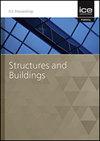Impact-induced vibration effects on the real dynamic behavior of cable-stayed bridges
IF 1.4
4区 工程技术
Q3 CONSTRUCTION & BUILDING TECHNOLOGY
Proceedings of the Institution of Civil Engineers-Structures and Buildings
Pub Date : 2022-11-11
DOI:10.1680/jstbu.21.00186
引用次数: 0
Abstract
Cable-stayed bridges are flexible and complex structures. Impact-induced vibrations may play an important role on the behaviors of the structural elements. Many efforts have been devoted to clarifying the experimental static and dynamic responses of cable-stayed bridges. However, experimental dynamic responses of structural elements of cable-stayed bridges under impact-induced vibrations have not been addressed widely in the literature. The paper focuses on the real experimental dynamic behaviors of cables, deck, and pylon in cable-stayed bridges under impact-induced vibration effects due to fully loaded trucks passing over a bump positioned on the deck center. The tests have been implemented on the new Kömürhan cable-stayed bridge under the passage of two-40 ton trucks. The thickness of the timber bumps and speed of the trucks are selected as 50mm and 30km/h, respectively. The dynamic responses of the structural elements have been recorded using load cells, 2D and 3D accelerometers. Forces, accelerations and frequencies of the main and back span cables, and acceleration responses of deck and pylon recorded with and without impact effects are evaluated and compared with each other. Significant impact-induced amplification ratios on the responses of the main and back span cables, deck and pylon are observed on the selected bridge.冲击诱发振动对斜拉桥实际动力性能的影响
斜拉桥是一种灵活复杂的结构。冲击引起的振动对结构元件的性能起着重要的作用。斜拉桥的静力和动力试验响应已经得到了广泛的研究。然而,斜拉桥结构构件在冲击振动作用下的动力响应实验研究尚未得到广泛的研究。本文重点研究了斜拉桥中斜拉桥索、桥面和塔在满载卡车通过桥面中心凸起时的冲击诱发振动作用下的实际试验动力行为。测试已经在新的Kömürhan斜拉桥上实施,该桥在两辆40吨卡车的通过下。木材颠簸的厚度和卡车的速度分别选择50mm和30km/h。结构元件的动态响应已被记录使用称重传感器,2D和3D加速度计。对主缆和后缆的力、加速度和频率以及甲板和塔的加速度响应进行了评估和比较。所选桥梁的主跨、后跨缆索、桥面和塔的响应均存在显著的冲击放大比。
本文章由计算机程序翻译,如有差异,请以英文原文为准。
求助全文
约1分钟内获得全文
求助全文
来源期刊
CiteScore
3.40
自引率
6.20%
发文量
61
审稿时长
12 months
期刊介绍:
Structures and Buildings publishes peer-reviewed papers on the design and construction of civil engineering structures and the applied research associated with such activities. Topics include the design, strength, durability and behaviour of structural components and systems.
Topics covered: energy conservation, people movement within and around buildings, strength and durability of steel and concrete structural components, and the behaviour of building and bridge components and systems

 求助内容:
求助内容: 应助结果提醒方式:
应助结果提醒方式:


